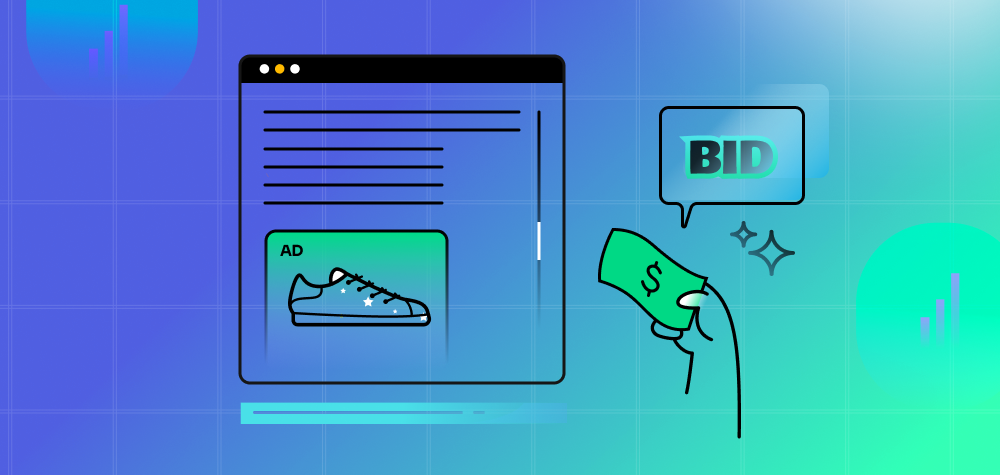It’s estimated that the average person sees somewhere between 4,000 and 10,000 ads per day. Most of those ads are bought and sold using an adtech practice called real-time bidding.
In this article, we’ll define real-time bidding, explore how it works, the pros and cons of real-time bidding, and the technology on the horizon that will affect real-time bidding in the future.
What is real-time bidding?
Real-time bidding is a micro-auction that’s completed in less than a second, when advertisers compete for digital ad space in real time.
Digital advertising is built on supply and demand: Websites and mobile apps cost a lot of money to run, so they offset those costs by creating ad units and placing them where people will see them as they consume content.
On the other side of the equation, advertisers want to put their ads in front of the people who are most likely to buy their products or use their services.
The multibillion-dollar advertising technology industry exists to connect supply (in this case, the publishers of websites and apps) with demand (advertisers and advertising agencies).
There are lots of ways to connect supply and demand. In the earliest days of the internet, this process was largely manual: Advertisers looked for websites that catered to their customer demographics, negotiated pricing, and ran their ad campaigns on specific websites for a specific amount of time. It was slow, expensive, and hard to measure which ads were reaching the right people.
Real-time bidding dramatically streamlines this process.
The winning ad loads virtually instantly on the website or mobile app you’re looking at, with all the details, such as ad targeting, price negotiation and payment agreements happening in the background, in a matter of milliseconds.
Every hour, billions of digital ads are bought and sold across the programmatic advertising ecosystem using real-time bidding.
How does the process of real-time bidding work?
Real-time bidding is a sophisticated, multistep process, where multiple adtech platforms need to work together in a very short amount of time to successfully deliver an ad.
Let’s first define a couple key terms:
- Publishers: The owners of the thing that’s displaying the ads—commonly a website, mobile app, podcast, streaming video platform, TV station, magazine publisher, billboard owner, etc.
- Supply-side platform: A software platform that represents the interests of the publisher. Publishers give SSPs information about the ad units they create, and the people who have landed on their media property. Supply Side Platforms exist to get publishers the highest possible ad rates.
- Advertisers: Companies that want to get messages in front of customers. Many advertisers are represented by advertising agencies.
- Demand-side platform: A software platform that represents the interests of advertisers and their ad agencies. Advertisers load their creative assets into Demand Side Platforms and define which types of customers they’re looking for and how much they’re willing to pay to reach those customers. DSPs exist to help advertisers reach their ideal audience at the most efficient price possible.
- Ad exchanges: SSPs and DSPs meet at the advertising exchange, which facilitates the real-time bidding process. Ad exchanges plug into multiple SSPs and DSPs, giving publishers access to many advertisers, and advertisers access to many outlets for their ads.
The role of SSPs in real-time bidding
The real-time bidding process starts with the publisher. As soon as someone lands on a page, or loads a mobile app, the publisher asks for an ad. This request gets routed through the publisher’s supply-side platform and lands at the ad exchange, where advertisers compete to win that ad unit.
Publishers send along additional information with their ad requests, such as more information about the specific webpage or app the customer is looking at, the customer’s location and language preferences, and any other data that might yield a better, higher-paying ad.
The publisher’s supply-side platform, or SSP, represents the publisher’s interests in the auction, in hopes of getting back an ad that’s relevant, and has a high CPM (the amount of money it costs to deliver 1,000 ad impressions). Here, publishers can set a price floor on their ad inventory—if they don’t get bids above that price, they don’t display an ad.
The role of DSPs in real-time bidding
Meanwhile, advertisers load their campaign requirements into their demand-side platform, or DSP, with varying levels of granularity. Ad campaigns might target people based on where they live, what language they speak, or their age, gender, estimated income, or specific interests. Here too, advertisers can set their maximum bid range and specify the names and types of publishers they don’t want to distribute ads to.
In real-time bidding, the supply side talks to the demand side using a standardized industry protocol called OpenRTB. Developed and maintained by the Interactive Advertising Bureau’s Tech Lab, this protocol standardizes the metadata fields that the supply side and demand side use to communicate.
These metadata fields include, among other things, information about the publisher, the dimensions of their ad units, the customer’s location, IP address, and/or inferred interests. Here’s an example of an OpenRTB request.
Armed with this information, SSPs and DSPs meet at an advertising exchange to conduct a real-time bid. Real-time bidding often follows what’s known as a Vickrey auction format—the advertiser that wins places the highest bid, but ultimately pays the price that the second-highest paying bidder offered.
This process happens within several hundred milliseconds, and is repeated over and over, hundreds of billions of times per day.
The benefits and challenges of real-time bidding
Real-time bidding solves a complicated marketplace problem at scale. And while it works very well, it’s not yet perfect. Here are the benefits and challenges of real-time bidding:
The benefits of real-time bidding
For publishers, real-time bidding helps fill ad units with relevant, high-paying ads instantly. Publishers can feel confident that they’re monetizing their platforms efficiently, by getting access to hundreds of thousands of advertisers and multiple competitive bids for their ad units.
For publishers, the biggest benefit of real-time bidding is how easy it is to participate in the global advertising marketplace.
For advertisers, real-time bidding gives them access to large digital properties, and the ability to build targeted campaigns that find prospective customers quickly and efficiently. Once in motion, advertisers can make changes to their campaigns to optimize ad performance.
Real-time bidding allows advertisers to reach their customers in a cost-effective way.
The challenges of real-time bidding
For publishers, the downside of real-time bidding is the relative lack of transparency and control over the types of ads that get displayed on their properties. A large website or mobile app might display ads from thousands of brands per day, selling a variety of products and services. Publishers need to trust that the adtech ecosystem will serve up relevant, useful, brand-safe advertising.
For advertisers, the downside of real-time bidding is also transparency and control. Given the velocity and scale of real-time bidding, advertisers need to trust that the adtech ecosystem is placing their ads in front of real, relevant customers. The advertising industry relies on performance tracking and management tools to figure out where their ads are being displayed, and whether those impressions are resulting in positive business outcomes.
What’s next for real-time bidding?
Artificial intelligence will continue to take over large parts of the real-time bidding ecosystem. Adtech companies like Start.io use artificial intelligence to improve ad requests as they’re being sent to an SSP, with the goal of commanding a higher CPM for publishers.
On the other side of the equation, adtech companies are using AI to personalize ads as an additional step inside the real-time bidding process, in hopes of improving their click-through rate.
The industry continues to experiment with transparency, performance measurement and attribution markers, which could be built on blockchain technology.
Meanwhile, the advertising industry is losing access to foundational tools such as third-party cookies and unique IDs, as Google, Apple, and other major players improve consumer privacy.
Despite its existing, high level of sophistication, real-time bidding will continue to improve over time.
Start.io is a leading player in the real-time bidding ecosystem. If you’re an advertiser, learn more about our omnichannel ad-serving capabilities. If you’re the publisher of a mobile app, download the Start.io advertising SDK.



